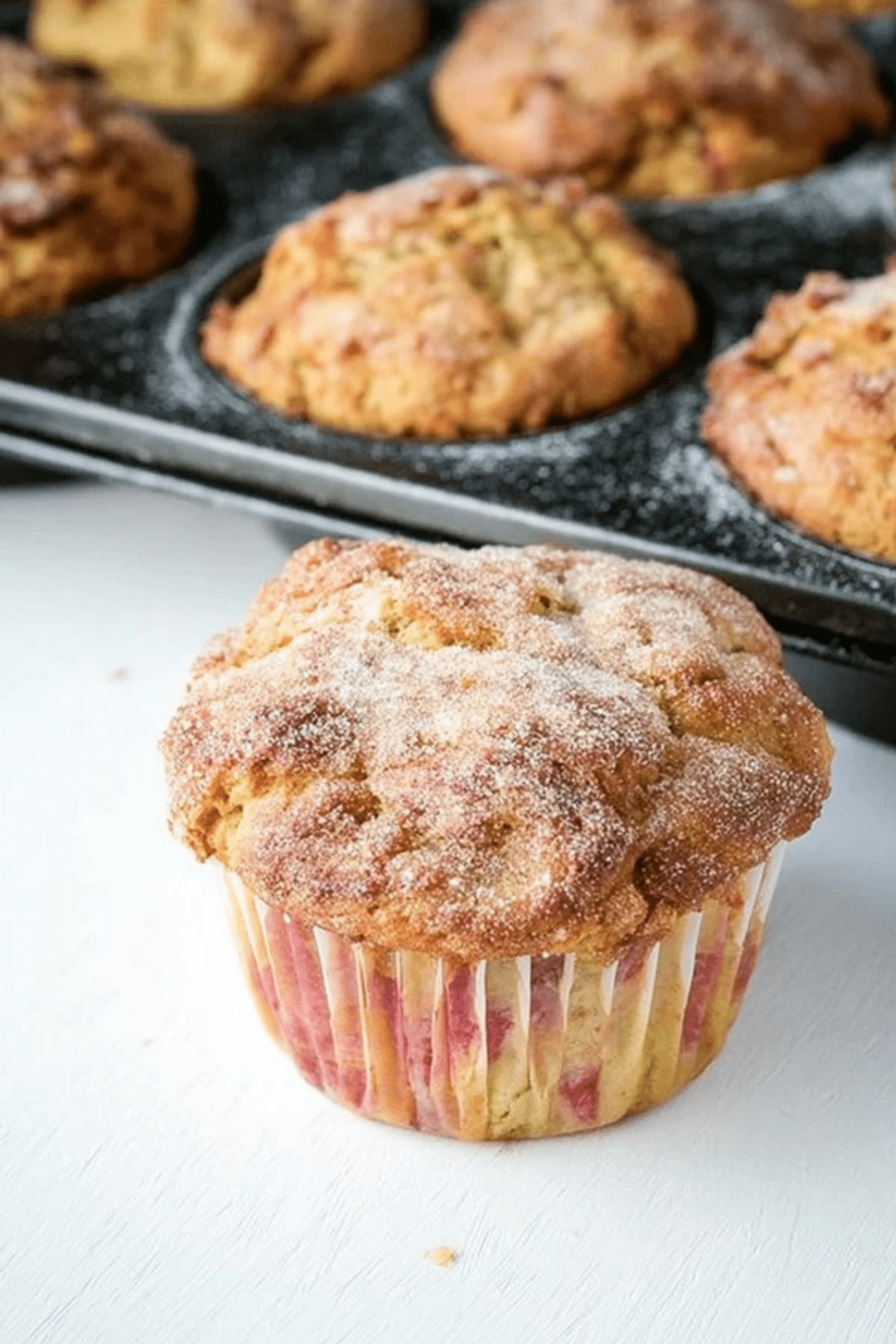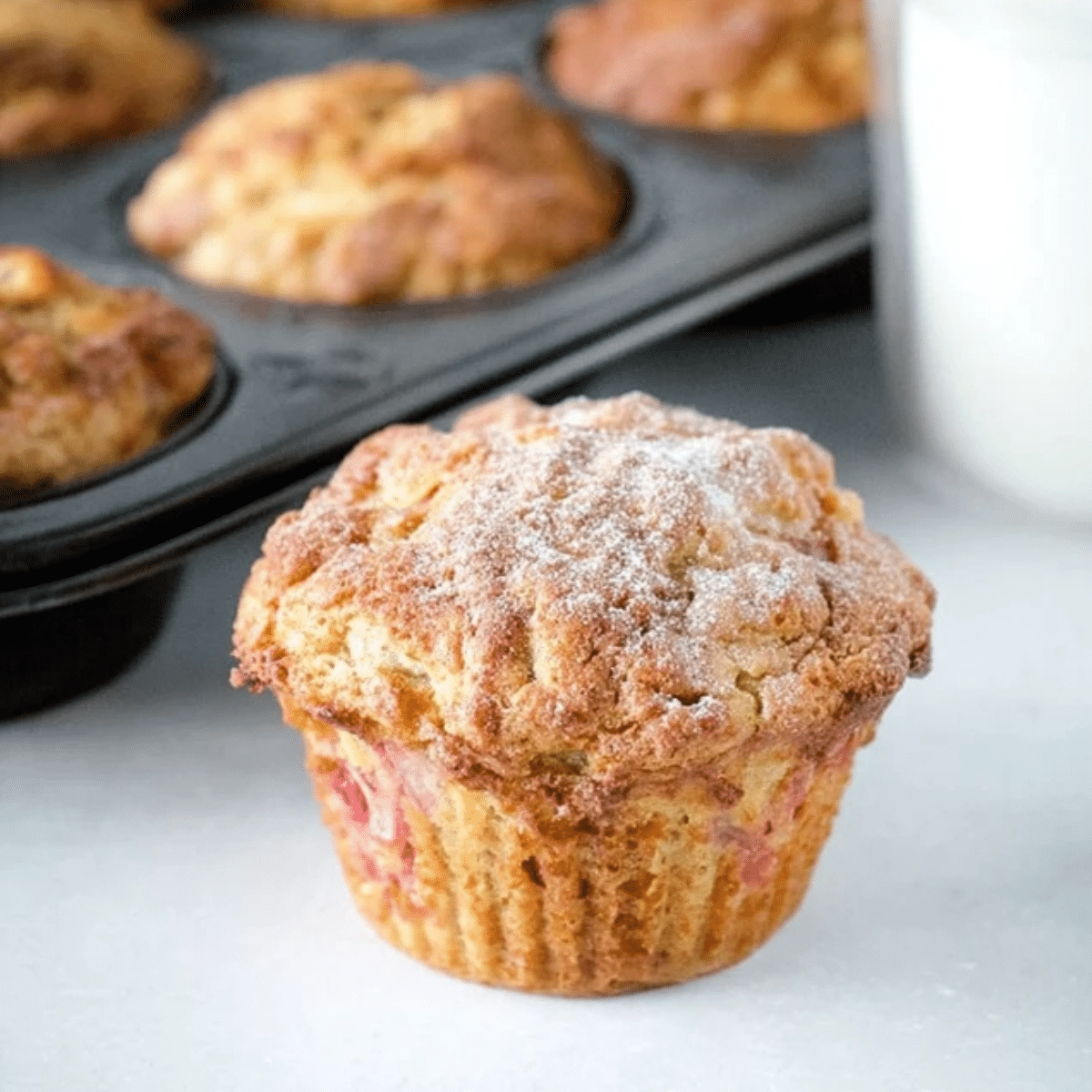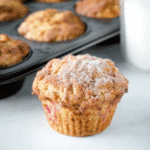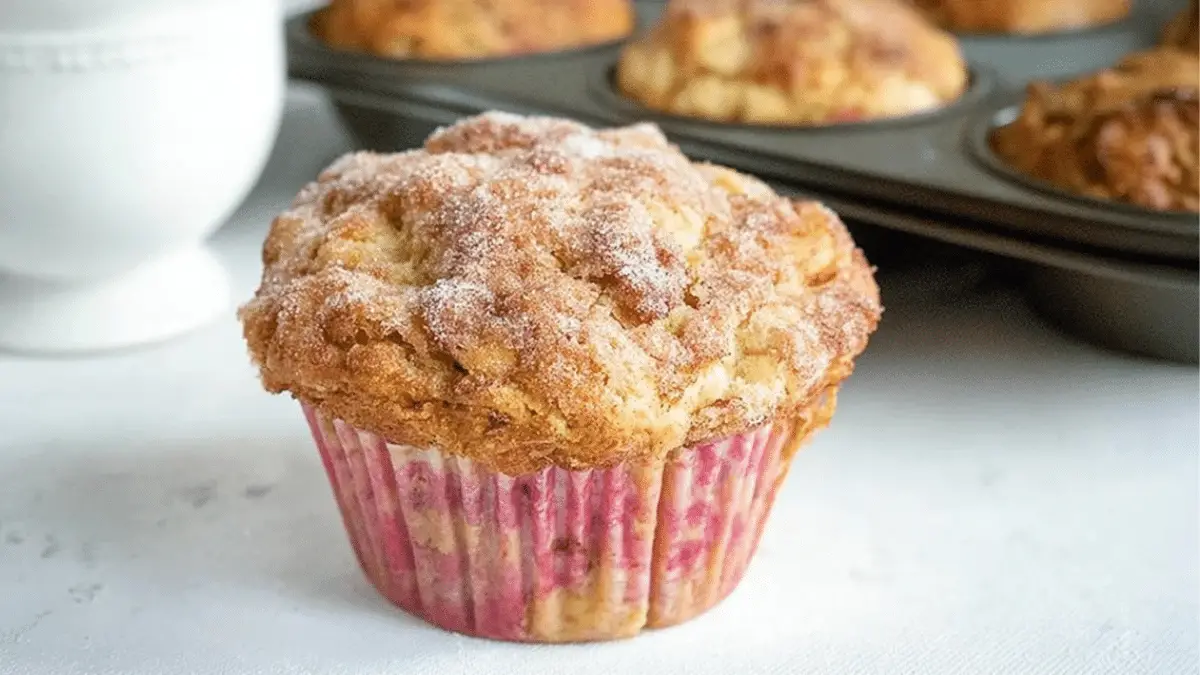If you’re looking for the perfect way to welcome rhubarb season, these Rhubarb Muffins with Greek Yogurt should be at the top of your baking list. With their tender crumb, bursts of tart rhubarb, and a subtle tang from Greek yogurt, these muffins strike the ideal balance between indulgence and health. In this guide, we’ll walk you through the benefits of using Greek yogurt in baking, how to select the best ingredients, step-by-step instructions, and creative variations. Whether you’re a weekend baker or looking for an easy make-ahead breakfast, this recipe delivers wholesome flavor in every bite. Looking for inspiration? Try our Banana Zucchini Muffins too for another spring-fresh option.
Table of Contents
The Irresistible Appeal of Rhubarb Muffins with Greek Yogurt
Why rhubarb and Greek yogurt make the perfect pair
At first glance, rhubarb and Greek yogurt might seem like an odd couple. But when you bake them together, magic happens. Rhubarb adds vibrant bursts of tartness that cut through the sweetness of muffins, while Greek yogurt provides a creamy richness and moisture without overwhelming the texture. Together, they create a muffin that’s not only soft and fluffy but also flavor-forward and unique.
Greek yogurt acts as a fat substitute in many baked goods, offering fewer calories and more protein compared to butter or oil alone. It also interacts with baking soda to give the muffins a lovely rise. Rhubarb, on the other hand, contributes fiber, vitamin K, and antioxidants, making this treat as nutritious as it is delicious.
Seasonal ingredients and flavor profile
These muffins shine brightest during spring and early summer, when rhubarb is in season. Its naturally tart flavor is mellowed in the oven and balanced by a cinnamon-sugar topping that crisps beautifully during baking. Paired with the creamy tang of Greek yogurt, the flavor profile becomes layered—tangy, sweet, and warm all at once.
Nutritional advantages of this muffin combo
Using Greek yogurt in place of sour cream or full-fat milk reduces saturated fat and increases protein content. Rhubarb, being low in calories but high in fiber, supports digestive health and adds volume without bulk. Combined, these two powerhouse ingredients produce a baked good that’s lighter, cleaner, and still full of flavor.
Choosing the Best Rhubarb and Yogurt for Baking
Fresh vs frozen rhubarb: What to use and when
Fresh rhubarb is always the gold standard in baking. It holds its shape well during baking and delivers maximum tartness and color. However, frozen rhubarb works just fine in a pinch—just be sure to thaw and drain it to prevent excess moisture from thinning your batter. Avoid rhubarb that is limp, brown, or overly woody.
Frozen rhubarb is convenient and often pre-cut, making it a time-saver for busy mornings. Just remember to reduce any added liquids in your recipe slightly to accommodate the extra moisture frozen rhubarb can introduce.
Selecting the right Greek yogurt (fat content, flavor, texture)
Not all yogurts are created equal. For the richest flavor and most reliable texture, opt for 2% plain Greek yogurt. Fat-free (0%) versions can make muffins gummy or too dry, while full-fat yogurt provides the richest flavor but can lead to a heavier result. Stay away from flavored yogurts, which introduce unwanted sugars and alter the flavor balance.
The yogurt should be thick and creamy, not watery. If your brand is particularly runny, strain it through a cheesecloth or coffee filter for 15–20 minutes to improve texture.
Common mistakes when combining yogurt and fruit in baked goods
Avoid overmixing the batter once you’ve added yogurt—it can lead to dense, chewy muffins. Also, toss rhubarb pieces lightly in flour before folding them into the batter. This helps distribute them evenly and prevents sinking. Finally, make sure all wet ingredients are at room temperature to ensure even mixing and baking.

Step-by-Step: How to Make Rhubarb Muffins with Greek Yogurt
Ingredients list and substitutions
Here’s what you’ll need to make a batch of 12 delicious muffins:
| Ingredient | Quantity |
|---|---|
| All-purpose flour | 1 cup |
| Whole wheat flour | 1 cup |
| Granulated sugar | ¾ cup |
| Baking powder | 2½ tsp |
| Baking soda | ½ tsp |
| Ground cinnamon | 1 tsp (plus more for topping) |
| Kosher salt | ½ tsp |
| Greek yogurt (2%) | 1 cup |
| Unsalted butter, melted | 8 tbsp |
| Large eggs | 2 |
| Vanilla extract | 1 tsp |
| Rhubarb, diced | 1½ cups |
| Sugar + Cinnamon (for topping) | 3 tbsp + ½ tsp |
Want to try another muffin base? Don’t miss our Pumpkin Cinnamon Roll Muffins that follow a similar method but with warm fall flavors.
Mixing method and baking tips
Start by preheating your oven to 400°F and lining a 12-cup muffin tin. In one bowl, whisk together the dry ingredients. In another, beat the wet ingredients until smooth. Combine them gently—fold just until you don’t see any more dry streaks. Add rhubarb, then divide the batter evenly across the cups. The cinnamon-sugar topping should be sprinkled generously on each before baking.
Bake for 20–22 minutes, or until a toothpick inserted into the center comes out clean. The muffins should be golden, domed, and slightly firm to the touch. Let them cool slightly before removing from the tin.
Looking for more quick breakfast bakes? Discover great ideas like Easy Blueberry Baked Oatmeal or our Strawberry Cinnamon Rolls.
Cinnamon sugar topping and texture hacks
The key to the bakery-style finish is the cinnamon sugar topping. Mix white sugar with a hint of cinnamon and sprinkle over each unbaked muffin. For extra texture, gently press it into the batter with your fingertips. The result? A sweet, slightly crunchy lid that contrasts perfectly with the soft interior.
You can even mix a pinch of cardamom or nutmeg into the topping for added complexity. Craving indulgence? A light dusting of coarse turbinado sugar adds sparkle and crunch.
Storage and Make-Ahead Tips for Busy Bakers
Best practices for storing muffins at room temp or freezing
Once completely cooled, your rhubarb muffins can sit at room temperature in an airtight container for up to 2 days. If you’re not planning to eat them that quickly, freezing is the best option. Wrap each muffin individually in plastic wrap, then store them in a zip-top freezer bag. They’ll stay fresh in the freezer for up to 3 months without losing their moisture.
To enjoy later, simply reheat in the microwave for 30–45 seconds, or let thaw on the counter overnight. This way, you always have a delicious breakfast or snack ready to go.
Reheating for best texture
When reheating, don’t overdo it. Overheating can cause the yogurt-based muffins to dry out. For a soft, just-baked feel, wrap a muffin in a clean paper towel and microwave in short bursts, checking after each. Or place them in a preheated oven at 300°F for 8–10 minutes. You’ll bring back the crisp top and pillowy center that makes these muffins irresistible.
Check out Homemade Coffee Ice Cream for a dessert pairing that complements these muffins beautifully.
How long do rhubarb muffins last?
At room temperature: 2 days
In the fridge (not recommended): up to 5 days, but texture may suffer
In the freezer: 2–3 months
Always make sure your storage container is airtight to preserve flavor and texture.
Creative Variations to Try with This Muffin Base
Substituting other fruits (raspberries, apples, berries)
This muffin base is extremely flexible. Can’t find fresh rhubarb? No worries—chopped apples, blackberries, blueberries, or even cranberries all bake up wonderfully. For extra brightness, consider adding citrus zest to the batter when using berries.
For an autumn twist, try mixing in apple chunks and a hint of nutmeg. If you love tartness, raspberries pair wonderfully with the cinnamon topping.
Making it vegan or gluten-free
To go vegan, substitute the Greek yogurt with a plant-based yogurt, like coconut or almond yogurt with a bit of lemon juice for tang. Use a flax egg or applesauce instead of real eggs, and a vegan butter alternative.
To make the muffins gluten-free, swap the flours for a 1:1 gluten-free flour blend and ensure your baking powder is certified GF. The texture will still be soft and springy if you don’t overmix.
Looking for more cozy gluten-free treats? Don’t miss our Cream Cheese Pumpkin Muffins—they’re rich, moist, and full of fall flavor.
Turning the recipe into a loaf or mini muffins
Yes, you can absolutely turn this into a rhubarb muffin loaf! Simply pour the batter into a greased 9×5-inch loaf pan and bake for 45–55 minutes at 350°F, checking doneness with a toothpick.
Mini muffins? Reduce baking time to 8–10 minutes at 400°F. Perfect for lunchboxes or brunch platters!

Frequently Asked Questions (FAQ)
Can I freeze muffins with Greek yogurt?
Yes! Greek yogurt-based muffins freeze just as well as traditional ones. Once cooled, wrap them tightly and freeze for up to 3 months. To reheat, microwave in 30-second bursts or warm in a 300°F oven for a better texture.
Why are my rhubarb muffins too wet or too dry?
If your muffins are too wet, it could be due to extra moisture from the rhubarb or overmixing. Be sure to pat dry thawed rhubarb and mix the batter until just combined. For dry muffins, check your oven temp and use a yogurt with at least 2% fat for moisture.
Is Greek yogurt healthier than sour cream in muffins?
Definitely. Greek yogurt has less fat and more protein than sour cream, making it a smart swap for lighter baking. It keeps your muffins moist and tender without the heaviness of traditional dairy fats.
Do I have to peel rhubarb before baking?
Not usually. Rhubarb’s peel is thin and breaks down during baking. However, if you’re using older, thicker stalks, you can lightly peel the outer layer to avoid stringy bits. Always trim the leaves—they’re toxic and should be discarded.
Conclusion: Bake a Better Muffin with Greek Yogurt and Rhubarb
Whether you’re prepping for a spring brunch, packing school lunches, or just craving something bright and fresh, Rhubarb Muffins with Greek Yogurt are a winning choice. They’re moist, balanced in flavor, and easily customizable for dietary needs. With Greek yogurt adding both creaminess and protein, and rhubarb offering a fresh zing, this muffin checks all the boxes for flavor and nutrition. Don’t miss our Apple Cider Braised Pork Shoulder if you’re planning a full spring menu around seasonal ingredients.
Print
Rhubarb Muffins with Greek Yogurt
- Total Time: 35–40 minutes
- Yield: 12 muffins
- Diet: Low Fat
Description
Moist and healthy Rhubarb Muffins made with Greek yogurt for a protein-rich, low-fat spring treat. Lightly sweet, cinnamon-spiced, and perfect for breakfast or snacks.
Ingredients
- 1 cup all-purpose flour
- 1 cup whole wheat flour
- ¾ cup granulated sugar
- 2½ teaspoons baking powder
- 1 teaspoon ground cinnamon
- ½ teaspoon baking soda
- ½ teaspoon kosher salt
- 1 cup 2% plain Greek yogurt
- 8 tablespoons unsalted butter, melted
- 2 large eggs
- 1 teaspoon pure vanilla extract
- 1½ cups diced rhubarb
- 3 tablespoons granulated sugar (for topping)
- ½ teaspoon ground cinnamon (for topping)
Instructions
- Preheat oven to 400°F. Line a 12-cup muffin tin with paper or foil liners.
- In a medium bowl, whisk together flours, sugar, baking powder, cinnamon, baking soda, and salt.
- In a large bowl, whisk together Greek yogurt, melted butter, eggs, and vanilla until smooth.
- Fold the dry ingredients into the wet ingredients until just combined.
- Gently stir in the diced rhubarb without overmixing.
- Divide the batter evenly among the 12 muffin cups.
- Mix 3 tablespoons sugar with ½ teaspoon cinnamon and sprinkle over each muffin.
- Bake for 20–22 minutes, until muffins are golden and a toothpick comes out clean.
- Let cool in the pan for 5–10 minutes, then transfer to a wire rack. Serve warm.
Notes
- Use fresh rhubarb when in season, or thawed frozen rhubarb (well-drained).
- Don’t overmix the batter to maintain a light texture.
- Store at room temperature for 2 days or freeze for up to 3 months.
- 2% Greek yogurt gives the best texture; avoid 0% for optimal moisture.
- Great base recipe—swap rhubarb for apples, berries, or cranberries.
- Prep Time: 15 minutes
- Cook Time: 20–22 minutes
- Category: Breakfast, Snack
- Method: Baking
- Cuisine: American
Nutrition
- Serving Size: 1 muffin
- Calories: 226 kcal
- Sugar: 16 g
- Sodium: 163 mg
- Fat: 9 g
- Saturated Fat: 5 g
- Unsaturated Fat: 3 g
- Trans Fat: 0.3 g
- Carbohydrates: 32 g
- Fiber: 2 g
- Protein: 5 g
- Cholesterol: 48 mg

